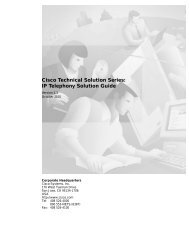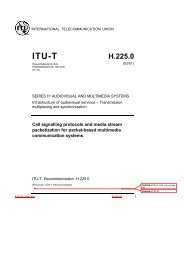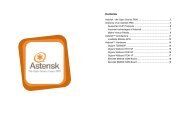An Introduction to Erlang B and Erlang C - VOIP Information
An Introduction to Erlang B and Erlang C - VOIP Information
An Introduction to Erlang B and Erlang C - VOIP Information
Create successful ePaper yourself
Turn your PDF publications into a flip-book with our unique Google optimized e-Paper software.
6 Telemanagement #187<strong>An</strong> <strong>Introduction</strong> <strong>to</strong><strong>Erlang</strong> B <strong>and</strong> <strong>Erlang</strong> CIf you make decisions about networks, PBXs,or call centres, you must underst<strong>and</strong> these conceptsIAN ANGUSthat actually works — uses mathematicalformulas that form the basis of the disciplinecalled “traffic engineering.” Someof them are easy for anyone <strong>to</strong> use; othersrequire expert support, or at least specializedsoftware. If you make configurationdecisions about networks, PBXs, or callcentres, you must underst<strong>and</strong> the basicconcepts involved, whether or not you plan<strong>to</strong> do the calculations yourself.“Hey, it’s simple arithmetic! We get 3,200 callsa day. That’s 400 calls an hour. Each call laststhree minutes, so each person can h<strong>and</strong>le 20calls an hour. So we’ll need 20 incoming lines<strong>and</strong> 20 people <strong>to</strong> answer the phones.”Does that sound familiar?Many telephone <strong>and</strong> call centre decisionsare made using just that logic. It’ssimple, <strong>and</strong> it’s clear — <strong>and</strong> it’s absolutelywrong. The problem can be summed upin three words: Calls Bunch Up.If you get 3,200 calls in an eight-hourday, <strong>and</strong> your calls follow a typical distributionpattern, 550 or 600 of them willarrive during the busiest hour of the day.It Started in DenmarkAll modern methods for optimizing networks have theirroots in work done by Agner Krarup <strong>Erlang</strong>, a scientistwho joined the Copenhagen Telephone Company in1908. He set out <strong>to</strong> solve the key problem in telephonenetwork design: how many trunks are needed <strong>to</strong> carry agiven amount of calling?Imagine a village in which every home has a telephoneconnected <strong>to</strong> a local switch. How many trunks shouldthe phone company install between that switch <strong>and</strong>the one in the next village? <strong>Erlang</strong> saw that there wasno absolutely correct answer. Rather, there is alwaysa trade-off between service <strong>and</strong> cost. In the case ofthe village, there are two extreme options, neither ofwhich is acceptable:<strong>An</strong>d then they will bunch up during thathour, leading <strong>to</strong> times when the phonesare going crazy <strong>and</strong> times when manylines are free.Then you have <strong>to</strong> take in<strong>to</strong> considerationthe fact that no one can h<strong>and</strong>le20 three-minute calls every hour withoutburning out, <strong>and</strong> that there is usually postcallwork <strong>to</strong> do in addition <strong>to</strong> talking <strong>to</strong>callers.In short, the “simple arithmetic” approachwill result in <strong>to</strong>o few trunks, <strong>to</strong>ofew people — <strong>and</strong> <strong>to</strong>o many very unhappycallers.The alternative — the only approachA.K. <strong>Erlang</strong>, 1878-1929! Provide just one trunk, <strong>and</strong> let callers wait until it’s available. The cost is low,but the service is unacceptably poor.! Provide one trunk for every local phone line, so no call is ever blocked. Theservice is excellent, but the cost is much <strong>to</strong>o high.The problem was <strong>to</strong> convert that insight in<strong>to</strong> hard numbers that would allownetwork planners <strong>and</strong> accountants <strong>to</strong> evaluate each possibility on the curvesbetween low <strong>and</strong> high cost, poor <strong>and</strong> excellent service.To do this, <strong>Erlang</strong> conducted the world’s first detailed studies of telephone traffic,<strong>and</strong> then developed mathematical formulas <strong>to</strong> evaluate the trade-offs. His work wasenormously influential worldwide. One Bell Labs researcher taught himself Danishjust <strong>to</strong> be able <strong>to</strong> read <strong>Erlang</strong>’s papers in their original form. In 1946, the InternationalConsultative Committee on Telephones <strong>and</strong> Telegraphs (CCITT) honoured him byadopting the name “erlang” for the basic unit of telephone traffic.Basic ConceptsUntil recently, anyone using traffic engineeringtechniques had <strong>to</strong> either masterthe mathematics, or learn <strong>to</strong> use thickbooks of tables based on them. Personalcomputers changed all that, first bymaking traffic programs widely affordable,<strong>and</strong> now by making them availableon the Internet. Several sources are describedin the box on page 7.But remember the phrase, “garbage in,garbage out.” Before you jump <strong>to</strong> yourbrowser, be sure you underst<strong>and</strong> somekey concepts.<strong>Erlang</strong>: The basic unit of telecom trafficintensity. Strictly speaking, an erlang iswhat mathematicians call a “dimensionlessunit,” representing continuous use ofone circuit. However, since a single circuitused continuously carries 60 minutes ofcalling in one hour, one erlang is usuallydefined as 60 minutes of traffic. If youreceive 300 two-minute calls in an hour,then you received 600 minutes, or 10 erlangs,of traffic in that hour.(For many years, AT&T <strong>and</strong> BellCanada insisted on measuring traffic inCCS — 100 call seconds — instead of themore convenient but not-invented-hereerlang. If you have data in CCS, divide thenumbers by 36 <strong>to</strong> get erlangs.)Busy Hour: Because “calls bunch up,”all traffic planning has <strong>to</strong> focus on peakperiods. It isn’t acceptable <strong>to</strong> provide excellentservice most of the time <strong>and</strong> terribleservice just when cus<strong>to</strong>mers want <strong>to</strong> makecalls. Most commonly, we take the busiesthour of each day for five or 10 days duringthe busiest time of year, then calculatethe average of those hours’ traffic load.That “Average Busy Hour” figure is used<strong>to</strong> determine the maximum number oftrunks or people needed.Server: Something that h<strong>and</strong>les calls.For example, in a call centre situationthere are two kinds of servers: the trunksReproduction in any form prohibited. For additional copies phone 905-686-5050.
July-August 2001 7Finding <strong>Erlang</strong> On-lineSoftware has replaced the thick books oftables that used <strong>to</strong> be basic equipment foranyone involved in optimizing telephonenetworks. The following are some usefulresources. Telemanagement has not testedall of these products, <strong>and</strong> does not endorseany of them. All prices are in U.S. dollars.! <strong>Erlang</strong> Calcula<strong>to</strong>r 1.0: <strong>An</strong> <strong>Erlang</strong> B program for Palmcomputers. This simple freeware program displays threeblanks: Fail Rate (Blockage), Traffic, <strong>and</strong> Lines. You fill in two<strong>and</strong> it calculates the third. Available from various sources,including www.palmspot.com, www.visorvillage.com, <strong>and</strong>www.palmblvd.com.! Westbay Engineers: A UK company that develops <strong>and</strong> sellstraffic calculation software, ranging from <strong>Erlang</strong> for Excel ($80) <strong>to</strong>complex network <strong>and</strong> call centre modeling <strong>to</strong>ols. Their websitefeatures the best on-line traffic calcula<strong>to</strong>rs we’ve seen, including<strong>Erlang</strong> B, <strong>Erlang</strong> C, <strong>and</strong> call centre staffing. They also have an easyweb address: www.erlang.com.! HTL Telemanagement: Turbo Tables ($595) was the firstprogram <strong>to</strong> add traffic formulas <strong>to</strong> Excel, <strong>and</strong> remains one of thebest. HTL focuses on call centre planning <strong>to</strong>ols, using Hills A, aproprietary extension of <strong>Erlang</strong> C. www.htlt.com.! Teleopti: A Swedish firm that sells software for call centremanagement <strong>and</strong> optimization. Their website includes a rathercomplex Java-based Call Center Wizard for calculating trunk <strong>and</strong>staffing requirements. www.teleopti.com.! <strong>Erlang</strong>-Software: <strong>An</strong>other source forPC traffic software, this one in Australia.Their <strong>Erlang</strong>-G program is said <strong>to</strong> include sixcommon traffic formulas. $40, with multiplecopydiscounts. members.iinet.net.au/~clark/index.html.! Certis Technologies: Their <strong>Erlang</strong>Calc 1.2 program isavailable in three versions: St<strong>and</strong>ard (<strong>Erlang</strong> B only, $39); Pro(<strong>Erlang</strong> B, Extended <strong>Erlang</strong> B, <strong>Erlang</strong> C, Daily Traffic, $69); Deluxe(<strong>Erlang</strong> B, Extended <strong>Erlang</strong> B, <strong>Erlang</strong> C, Daily Traffic, Spreadsheetfor <strong>Erlang</strong> B Batch-Processing, Graphical Presentation of Results,$89). Free trial versions are available. www.certis.com/.! ClienTel: Don’t be dismayed when you find that the homepage is in Dutch. Just click on Online Call Center Assistant for<strong>Erlang</strong> B <strong>and</strong> <strong>Erlang</strong> C calcula<strong>to</strong>rs <strong>and</strong> a 24-hour call centrescheduling program. www.clientel.nl/.! Maths.org: Interested in the math behind <strong>Erlang</strong>’s formulas?There’s a tu<strong>to</strong>rial, including some simple on-line calcula<strong>to</strong>rs, atplus.maths.org/issue2/dar/index.html.! Basic on-line calcula<strong>to</strong>rs. When you need quick answers,these non-commercial sites can be useful. Most use few graphics<strong>and</strong> download quickly, a major advantage.www.dcss.mcmaster.ca/~qiao/publications/erlang/erlang.htmlmmc.et.tudelft.nl/~frits/<strong>Erlang</strong>.htmwww.owenduffy.com.au/electronics/telecommunications.htmwww.cs.vu.nl/~koole/erlang.htmlpersoweb.francenet.fr/~hilleret/that carry the calls, <strong>and</strong> the agents whoanswer them. With a voice mail or IVRsystem, the servers are ports.Grade of Service: The probability thatall servers will be busy when a call attemptis made. For example, on a trunk group:P.02 means that there is a 2% probabilityof getting a busy signal (being “blocked”)when you have a given amount of traffic<strong>and</strong> a given number of trunks. In a callcentre, the same number would mean thatthere is a 2% probability of having <strong>to</strong> wait<strong>to</strong> speak <strong>to</strong> a human.Probability FormulasThere are many traffic formulas, appropriate<strong>to</strong> many different situations, but twoof them, both developed by A.K. <strong>Erlang</strong>,cover the most common business telecomrequirements.<strong>Erlang</strong> B: This is the formula <strong>to</strong> usewhen a blocked call is really blocked —for example, when somebody calls yourphone number <strong>and</strong> gets a busy signal ortries <strong>to</strong> access a tie trunk <strong>and</strong> finds it inuse. It is built around three variables: Servers,Traffic, <strong>and</strong> Grade of Service. If youknow any two of those, the formula willcalculate the third one.<strong>Erlang</strong> C: Use this formula when ablocked call is delayed — for example,when someone calls your call centre <strong>and</strong>must wait for an agent <strong>to</strong> take the call.It uses the same three variables, plus theaverage length of each call, <strong>to</strong> calculate theprobability of being delayed <strong>and</strong> how longthe delay is likely <strong>to</strong> be.These formulas only work if you havea large number of independent sourcesof traffic. For example, 10 people makingoutgoing calls, with no incoming calls,will never need more than 10 trunks, nomatter what the formula says! A mathematicianwill tell you that these formulasrequire “infinite sources,” but in practicethey work very well if there are at least 10times as many possible sources (callers)as servers (trunks or agents).<strong>Erlang</strong> B: The Easy OneThe most common traffic engineeringproblem involves sizing a trunk group— how many trunks are needed <strong>to</strong> carryyour <strong>to</strong>ll-free calls, how many tie trunksbetween two offices, how many ports in<strong>to</strong>your voice mail system, or some similarquestion. <strong>Erlang</strong> B h<strong>and</strong>les that relativelyeasily, in four steps:1. Collect traffic data. You need <strong>to</strong>know how much traffic will try <strong>to</strong> use thetrunk group, each hour, for five or 10 businessdays. You may be able <strong>to</strong> use phonebills, call detail reports, carrier traffic studies,or even manual counts — or you mayjust have <strong>to</strong> make educated guesses. Theobjective is <strong>to</strong> produce an hour-by-hourspreadsheet, showing the number of minutesof traffic in each hour. Divide thosenumbers by 60 <strong>to</strong> get erlangs per hour.Bear in mind that the traffic on yourtrunks may be greater than actual conversationtime — you must allow for dialingtime on outgoing calls, <strong>and</strong> for ringingtime on incoming calls, for example.2. Determine the Average Busy Hour.Select the busiest hour of each businessday, <strong>to</strong>tal the traffic, then divide by thenumber of days.Reproduction in any form prohibited. For additional copies phone 905-686-5050.
8 Telemanagement #1873. Choose a target Grade of Service. Inmost cases, a target of P.05 is acceptable,P.10 is terrible, <strong>and</strong> P.001 is so good thatmost callers will never get a busy signal.4. Use <strong>Erlang</strong> B. Calculate the numberof trunks you need <strong>to</strong> carry that amount oftraffic with your target Grade of Service.At this point, you need <strong>to</strong> decide whetherthe answer is acceptable. Usually, thatmeans deciding whether you can affordthe number or trunks or ports required.If not, try reducing the number of trunks<strong>and</strong> see what the effect is on the Grade ofService. You may discover that the differenceis negligible — or you may decidethat you have <strong>to</strong> get a budget increase orfind some way <strong>to</strong> reduce the amount oftraffic. (Are those calls really necessary?)The best thing about the various PC<strong>and</strong> Internet traffic calcula<strong>to</strong>rs is that theymake it very easy <strong>to</strong> do multiple calculationsuntil you find a balance between cost<strong>and</strong> service you can live with.<strong>Erlang</strong> C: More DifficultBecause <strong>Erlang</strong> B is so simple <strong>to</strong> use (inserttwo numbers, it calculates the third), manymanagers assume that <strong>Erlang</strong> C will besimilarly easy. That’s a mistake — evenbasic <strong>Erlang</strong> C calculations are difficult,<strong>and</strong> more complex ones can be dauntingindeed.<strong>Erlang</strong> C is most commonly used <strong>to</strong>calculate how long callers will have <strong>to</strong> waitbefore being connected <strong>to</strong> a human in acall centre or similar situation. This addsRelated Reading! Call Center Management on Fast Forward,by Brad Clevel<strong>and</strong> <strong>and</strong> JuliaMayben, includes a useful plain-Englishdiscussion of using <strong>Erlang</strong> C forcall centre planning. Order fromwww.incoming.com! Tables for Traffic Management <strong>and</strong>Design, by Ted Frankel, seems <strong>to</strong> bethe only book of traffic tables still inprint. Lee Goeller’s introduction <strong>and</strong>Frankel’s first three chapters constitutean excellent brief course in trafficengineering concepts. Order fromwww.abcteletraining.com.! Cisco’s website has useful tu<strong>to</strong>rials.Go <strong>to</strong> www.cisco.com <strong>and</strong> type “TrafficEngineering” in<strong>to</strong> the searchbox.<strong>Erlang</strong> B:<strong>Erlang</strong> C:complexity in at least four areas.1. What’s included in call times? In aqueuing system, traffic includes not just“conversation minutes,” but also the timeagents spend doing “post-call work” related<strong>to</strong> that conversation. Gathering accuratedata on this can be much more difficultthan just looking at a traffic study ora <strong>to</strong>ll-free service bill. In theory, your ACDreports provide the information — butthat only works if everyone has been pressingthe right but<strong>to</strong>ns at the right times.2. What’s meant by delay? The “AverageDelay” might be the average of all calls,including all the calls that didn’t wait at all,or it might be the average of calls that actuallyexperienced a delay. The latter figure isusually more useful, but you must be veryclear which one you are concerned with.Also, using averages can conceal situationsin which most delayed calls wait onlya few seconds, but some experience verylong delays. That can be a serious cus<strong>to</strong>merservice problem, even if the averageslook good.Most call centres summarize theirdelay objectives in a phrase like “answer80% of calls within 20 seconds,” but gettingfrom the <strong>Erlang</strong> C formula <strong>to</strong> thatresult can be difficult.3. What’s the hour-by-hour load? Withtrunks, you don’t have the option of addingor removing circuits every hour, so youmust install <strong>and</strong> pay for the numberneeded under peak load conditions. Withpeople, the peak period determines maximumstaffing, but you also need <strong>to</strong> calculatestaff requirements for other times,<strong>and</strong> plan staff scheduling accordingly.This usually means doing separate calculationsfor each half hour period in everyweek you operate.<strong>An</strong>d bear in mind that the <strong>Erlang</strong> Cforecast only tells you how many peoplemust be answering phones at any giventime. That’s quite different from thenumber you must schedule <strong>to</strong> work eachday, since almost no one can be on thephones 60 minutes an hour.4. How does waiting time affecttrunk load? The time a caller spendson hold listening <strong>to</strong> music adds <strong>to</strong> yourtrunk traffic — you can save money byhaving fewer agents <strong>to</strong> answer calls, butthat may require adding trunks <strong>and</strong>/orincreasing your <strong>to</strong>ll-free service bill. Youmay have <strong>to</strong> do several iterations <strong>to</strong>determine the optimal mix of trunks,people, <strong>and</strong> delay.These issues mean that anyone doinganything more than the simplest delaycalculations — above all anyone doingregular staff <strong>and</strong> configuration planningfor a call centre — should consider buyingspecialized call centre planning software.All such programs — despite the fact thatevery one claims <strong>to</strong> be absolutely unique— are ultimately based on A.K. <strong>Erlang</strong>’sformulas from 90 years ago.If you are comfortable with the math<strong>and</strong> at creating spreadsheets, considerbuying one of the commercial programsthat adds traffic formulas <strong>to</strong> Excel, makingit much easier <strong>to</strong> do multiple “what if”calculations.Every telecom professional should haveat least a general familiarity with<strong>Erlang</strong> B <strong>and</strong> <strong>Erlang</strong> C. However, whetheryou use them yourself or evaluate reportsproduced by others, always keep threethings in mind.! Using math is no substitute for usingyour head. If the data you plug in <strong>to</strong> theformulas isn’t valid, the answers won’t beany good either.! All formulas make assumptions thatsimplify reality. <strong>Erlang</strong> B assumes thatcallers who receive busy signals won’t immediatelytry again. <strong>Erlang</strong> C assumesthat delayed callers will wait on hold indefinitely.For low blockage rates <strong>and</strong> shortqueues, those assumptions don’t cause aproblem — but when your service level ispoor, they can give misleading results.! All traffic formulas calculate probabilities,not absolutes. <strong>Erlang</strong> B <strong>and</strong> Cpredict what will happen, on average,over many hours with similar traffic. Youractual experience in any specific hour canbe quite different.!Reproduction in any form prohibited. For additional copies phone 905-686-5050.
TelemanagementThe <strong>An</strong>gus Report on Business Telecommunications in Canada<strong>An</strong>gus TeleManagement Group Inc.8 Old Kings<strong>to</strong>n Road, Ajax ON L1T 2Z7Tel: 905-686-5050 ext 500 • Fax: 905-686-2655www.angustel.ca • admin@angustel.caKeeping decision makers ahead of <strong>to</strong>day’s revolution in business telecom <strong>and</strong> networkingSince 1983, decision makers across Canada have dependedon Telemanagement for independent, management-orientedanalysis <strong>and</strong> information about the fast-changing world ofbusiness telecommunications <strong>and</strong> networking.Telemanagement cuts across hype <strong>and</strong> oversell, delivering theinformation you need in order <strong>to</strong> determine what is reallyuseful <strong>and</strong> practical for your organization <strong>to</strong>day, <strong>and</strong> howchanges in networking <strong>and</strong> telecom will affect you. It stressesconcise, clearly written <strong>and</strong> tightly edited reports, for managerswho must make hard decisions about telecommunications<strong>and</strong> the role it plays in their organizations' strategic plans.Each issue of Telemanagement puts <strong>An</strong>gus TeleManagementGroup’s expertise <strong>to</strong> work for you ... translating technicaljargon ... making sense of complex regulations ... explainingthe impact <strong>and</strong> importance of all key developments, as theyaffect you <strong>and</strong> your organization.Business telecommunications is <strong>to</strong>o important <strong>to</strong> be left <strong>to</strong>chance, ignored, or managed using yesterday’s concepts <strong>and</strong>information. Start benefiting from the number one telecommunicationsinformation source in Canada.We invite you <strong>to</strong> subscribe ... <strong>and</strong> <strong>to</strong> protectyour investment with this unique <strong>and</strong> ironclad100% Money-BackGuarantee of SatisfactionYour subscription is absolutely risk free. Here’s why:If Telemanagement doesn’t provide the accurate,reliable information you need, just write <strong>and</strong> tell uswhy. We’ll immediately refund your money. Not justfor the undelivered issues, but every cent you paidfor this subscription. The issues you have alreadyreceived will be yours <strong>to</strong> keep with our thanks.This is the strongest, fairest guarantee you’ll find anywhere.We make this unique offer because we’re confident thatyou’ll find Telemanagement <strong>to</strong> be worth many times thesubscription price, <strong>and</strong> that once you start reading it, you’llcontinue <strong>to</strong> subscribe for years <strong>to</strong> come.FOUR EASY WAYS TO SUBSCRIBEWEB: www.angustel.ca(Secure on-line payment available)PHONE: 1-800-263-4415 x500FAX: 905-686-2655MAIL: Telemanagement, 8 Old Kings<strong>to</strong>n Road,Ajax, Ontario Canada L1T 2Z7In Canada: One Year (10 issues) C $385.00 Two Years (20 issues) C $725.00 (Best Deal: Save 52%)Other countries: One Year (10 issues) US $325.00 Two Years (20 issues) US $600.00PLEASE PRINT CLEARLYNameTitleOrganizationAddressCityProv/StatePostal/Zip CodePhoneFaxE-mailCharge <strong>to</strong>: Visa American Express MastercardAccount #For MasterCard, please provide full 19-digit account # on back of card.ExpirySignatureIan <strong>and</strong> Lis <strong>An</strong>gus have been the Publishers <strong>and</strong> Senior Edi<strong>to</strong>rsof Telemanagement since 1983. The Financial Post called them“Canada’s best-known telecom consultants.” OA Magazinedescribed them as “visionaries in telecommunications.” Theyhave twice won major awards from the Canadian BusinessTelecommunications Alliance, “in recognition of their leadership <strong>and</strong>infl uence on the Canadian telecommunications environment.” Full payment enclosed: $____________________(Please add applicable GST or HST - BN# 10021 5995 RT) Please Invoice FREE WEEKLY UPDATES! Check here <strong>to</strong> confi rm that youalso want <strong>to</strong> receive Telecom Update – <strong>An</strong>gus TeleManagement’stelecom newsbulletin – by e-mail every week, absolutelyfree! (It will be sent <strong>to</strong> your e-mail address, so pleasemake sure you have printed it clearly <strong>and</strong> correctly.)






